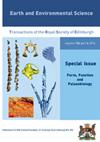10Be exposure age dating of Late Quaternary relative sea level changes and deglaciation of W Jura and NE Islay, Scottish Inner Hebrides
IF 1.2
4区 地球科学
Q4 GEOSCIENCES, MULTIDISCIPLINARY
Earth and Environmental Science Transactions of the Royal Society of Edinburgh
Pub Date : 2022-09-01
DOI:10.1017/S175569102200010X
引用次数: 0
Abstract
ABSTRACT New 10Be exposure age dating and geomorphological mapping of emerged shoreline features in W Jura and NE Islay throw new light on the regional pattern of ice sheet deglaciation and late-glacial relative sea level change. We conclude that the oldest and highest emerged shorelines in this area were produced ~15.7–16.3 ka, shortly after ice sheet deglaciation ~16.5 ka. It is envisaged that the first incursion of marine waters into coastal areas took place close to a former ice sheet margin that oscillated in position across this part of the Scottish Inner Hebrides. The first evidence of late-glacial marine sedimentation following deglaciation consists of emerged marine terrace fragments and unvegetated gravel beach ridges, the former represented by a prominent glacio-isostatically tilted shoreline that declines in altitude NE to SW, from ~40 m above ordnance datum (OD) in NW Jura to ~19 m OD in central Islay. In W Jura, north of Loch Tarbert, spectacular staircases of up to 55 unvegetated gravel beach ridges were formed shortly after regional deglaciation, possibly within 1 ka. A preliminary estimate of the average rate of relative sea level lowering across W Jura between deglaciation and the Younger Dryas is in the order of ~7 mmyr−1. Geomorphological evidence from Shian Bay, W Jura, indicates a truncation of the late-glacial beach ridge staircases by a large 480-m-long beach ridge (the Colonsay Ridge) at ~14.9 ka, when former relative sea level was at ~18 m OD. This ridge may represent the product of either a stillstand in the progressive lowering of relative sea level during the late-glacial or a reversal. This raises the intriguing possibility of an association between ridge formation and the timing of the well-established global meltwater pulse 1A between ~14.65 and ~14.8 ka.苏格兰内赫布里底群岛W Jura和NE Islay晚第四纪相对海平面变化和冰川消融的10Be暴露年龄测定
新的10Be暴露年龄定年和北侏罗和北侏罗出现的海岸线特征地貌填图,为揭示冰盖消冰和晚冰期相对海平面变化的区域格局提供了新的思路。我们认为,该地区最古老和最高的海岸线形成于~15.7 ~ 16.3 ka,在冰盖消融~16.5 ka之后不久。据设想,海水第一次侵入沿海地区发生在靠近苏格兰内赫布里底群岛这部分地区的前冰盖边缘。退冰后晚冰期海洋沉积的第一个证据是出现的海相阶地碎片和无植被的砾石滩脊,前者以突出的冰川-均衡倾斜海岸线为代表,其高度从东北向西南下降,从西北侏罗的地形基准面以上~40 m下降到伊莱岛中部的~19 m OD。在塔伯特湖(Loch Tarbert)北部的西侏罗(wjura),在区域冰川消退后不久,可能在1 ka内形成了多达55个未被植被覆盖的砾石海滩山脊,形成了壮观的阶梯。据初步估计,在消冰期和新仙女木期之间,整个西侏罗大陆的平均相对海平面下降速率约为~7 mmyr−1。来自西侏罗石安湾的地貌证据表明,在约14.9 ka,当以前的相对海平面约18 m OD时,一个480 m长的大海滩脊(Colonsay ridge)截断了晚冰期海滩脊阶梯。这个山脊可能代表了晚冰期相对海平面逐渐下降的静止状态或反转的产物。这提出了一种有趣的可能性,即脊的形成与公认的全球融水脉冲1A的时间在~14.65 ~ ~14.8 ka之间存在联系。
本文章由计算机程序翻译,如有差异,请以英文原文为准。
求助全文
约1分钟内获得全文
求助全文
来源期刊
CiteScore
2.00
自引率
0.00%
发文量
21
期刊介绍:
Earth and Environmental Science Transactions (formerly Transactions of the Royal Society of Edinburgh: Earth Sciences) is a general earth sciences journal publishing a comprehensive selection of substantial peer-reviewed research papers, reviews and short communications of international standard across the broad spectrum of the Earth and its surface environments. The journal prides itself on the quality of its graphics and photographic reproduction. The Editors are keen to encourage interdisciplinary papers and Transactions also publishes occasional special symposia and invited volumes of specific interest.
We are currently in the process of digitising the archive of RSE Publications, and the archive of the Transactions, dating back to 1788, will be available from the back issues link on this site.

 求助内容:
求助内容: 应助结果提醒方式:
应助结果提醒方式:


